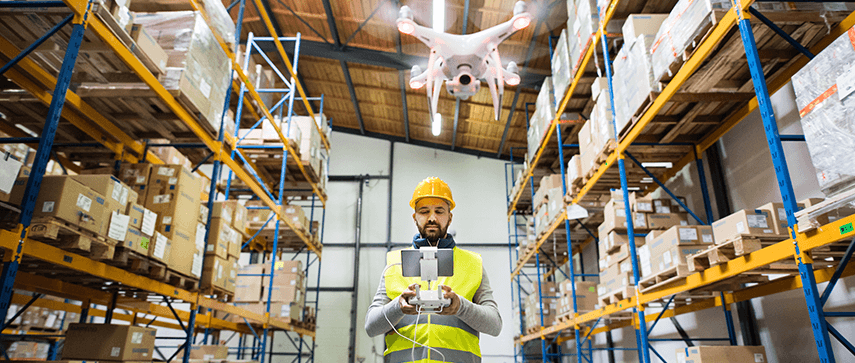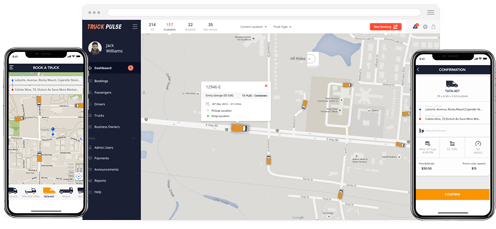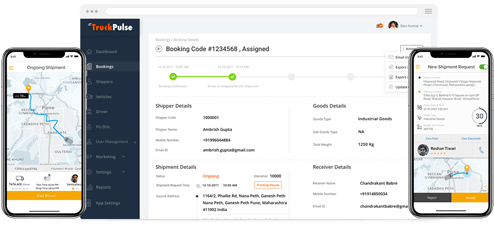Internet of things is empowering the logistics and supply chain industry and bridging the gap between the point of origin and point of destination in a way never seen before. IoT has much more to offer in the transportation and logistics industry. We often come across the phrase “Time is Money”. Yes, the Internet of Things is enabling the Cargo Industry to maximize their profitability by minimizing the operational time. Logistics and supply chain enterprises can track and achieve the overall functionalities with a crystal clear view.
The Cargo Industry is already getting tremendous benefits on a 24x7 basis with the advent of IoT and the IoT has plenty to offer in the coming days to the logistics and supply chain industry as they are very closely related to each other.
Nowadays, internet connectivity is not only limited to personal computing or mobile computing. In fact, it has extended its wings far beyond imagination. IoT is a combination of internet, hardware, software, electronics, and sensors. IoT devices can be used in different sectors like home automation, industrial automation, vehicles, and wearable devices.
In the logistics and supply chain system, IoT can be extensively used for controlling, coordinating, and processing among various transportation networks. The interaction between different IoT devices in the transportation system enables cross communication at all levels, leading to smart logistics and transportation solutions. With the advent of IoT, technology workers are now well-equipped with devices like smartphones, sensors, scanners and other smart devices which helps them operate in the logistics setup with speed and accuracy.
IoT Use Cases in the Logistic Industry
- Warehouse Management and Transportation

Warehouse transportation plays a vital role in logistics and transportation companies. It helps businesses efficiently and smoothly manage and speed up the entire process of warehousing operations and management. IoT goes hand-in-hand and is a key player in the processing, retrieval, dispatch, and delivery of goods in the fastest possible way. IoT helps in adhering to quality standards, track inventory, and monitor workers. Different cameras, sensors, GPS navigation, barcode scanners, radio frequency, and identification devices are employed in an IoT environment.
With the implementation of IoT, manual intervention and man-hours can be reduced to a greater level, creating a better and smarter warehouse functioning process. IoT technology helps warehousing and storage facilities in different ways, giving them better safety, minimal losses, and lessened human errors. Warehouse management is not an easy task but with the advent of IoT, warehouses can be connected and utilized optimally.
Sensors are being used to monitor the assets and check whether everything is properly connected and working smoothly in a warehouse. Using IoT, managers can easily observe speed, productivity, location, visibility of inventories in a real-time environment.
Connected assets using IoT in a warehouse also provides a platform to predict if there is any requirement of maintenance of the warehouse transportation network. The combination of cameras and sensors can detect if there is an issue with the storage otherwise, place them in a well-ordered manner. IoT also enables warehouses to control the lighting conditions as per the requirements in a warehouse.
- Visibility of Inventories and Assets from Point of Origin to Point of Delivery
Tracking and tracing of goods is a key component in the logistics and transportation industry. In an IoT setup, everything remains connected - be it the workforce or different devices which makes things visible and clear. IoT connects physical to digital and provides a platform for fast and accurate delivery of goods across all modes of transportation.
IoT makes it possible for real-time access and visibility of inventories. IoT transportation provides a great opportunity for all the staff members to have a better and clear view of the assets and goods at all levels, whether it’s the warehouse, packaging, shipping or delivery points. All this together has proved to be a great empowering tool in the transportation sector.
- Predictive Analytics with the Internet of Things
Business decision making is all about choosing a particular set of action among many alternatives. With the implementation of IoT and its predictive features, it empowers logistics enterprises with better decision-making capabilities. It also enables to predict in the early maintenance of devices and vehicles used in the supply chain industry.
Predictive analytics is gaining importance in different sectors and industries. It plays a major role in helping companies to come up with effective strategies, improve their decision-making processes and also manage risk well.
- Automated Vehicles
Automated vehicles will soon take over and this is being tested right now. The ones to take advantage of this will be the logistic companies. Automated vehicles will help logistics enterprises cut the overall operating cost and reduce accidents to a large extent. Self-driven vehicles are of great help in many ways. With IoT transportation used in vehicles, the level of accuracy also increases as compared to human drivers. Automated vehicles work flawlessly and the margin of error can also be minimized to a much larger extent with the IoT technology.
Since everything is machine oriented, things are all connected to each other. The operation of vehicles are controlled using artificial intelligence, hence IoT transportation is being adopted by new transportation companies quite rapidly today.
- Usage of Drones
IoT technology is empowering logistics enterprises with drone-based delivery of goods, helping to increase efficiency and speed. The most popular means of transportation used since ages include roadways, railways, and airways. Out of them, airways is the fastest one for shipping goods from one place to another. With the onset of drones, logistic and supply chain industries see a dramatic change.
Drones are being successfully used at a local level for transportation of goods. Even food deliveries are being carried out using drones in many cities around the globe. Drones are connected with IoT technology and are proving to be the fastest means of transportation at the local level for delivering light-weight goods. This is similar to airplanes being used for shipping heavier goods. Drones reduces a lot of man-hours, making the hassles of transportation simple and easy. - Location Management

IoT technology helps in location management and smooth operation of business management. GPS navigations and area locators offered by IoT is a great way to make location tracking simple and time-saving. End-to-end transportation and location tracking are getting simpler. IoT technology in transportation doesn’t require to find and track location manually since everything is automated and easily accessible.
Wireless sensors in an IoT environment can easily trace and monitor the exact location and condition of the shipment or the cargo. This seamless connectivity makes it possible to track and predict if there is any delay or any sort of damage to the cargo. IoT technology is not only great in terms with finding the location, but it is also helpful in monitoring weather conditions as well. With IoT, companies can easily track vehicles, deliveries, and driver activities. Once goods are delivered to a particular place, managers will be notified immediately by a simple push message process.
IoT Best Practices in Logistics
- Safety and Security
One of the key components of IoT is to provide safety and security to the assets and employees. Visual sensors and acoustic sensors can detect issues in order to avoid any sort of accidents in the overall process of transportation.
IoT also plays a major role in healthcare organizations as well. They are moving forward and are leveraging IoT for a number of different wellness applications. Monitoring blood glucose levels for diabetes patients, hours of sleep, calories burned and steps taken are some of the things that are changing drastically. One of the biggest changes happening in the health sector is the handling of chronic diseases and monitoring patient health like medications, blood pressure etcetera. IoT has the capability to reduce medical errors and help in times of emergencies as well.
IoT has worked wonders when it comes to security. Home-security solutions now enable people to lock and unlock their home doors from anywhere just by using a mobile application, With the help of sensors, alarms go out instantly if doors or windows are opened unexpectedly and this proves to be very helpful in times of robberies.
- Customer Experience
The IoT will soon be instrumental in creating great customer experiences in the retail industry too. Checkout optimization tools and in-store guidance experiences for shoppers are some of the things expected to give customers a great experience. Sensors and beacons for customer recognition that connect to smartphones and mobiles will take over as well. These sensors are relatively low-cost and can be attached practically anywhere to walls, ceilings, doors, and even mannequins. Customer experience will soon increase drastically with IoT.
Conclusion
IoT transportation industry is simply reaching the unreached and connecting the unconnected with optimum utilization of available resources. IoT not only speeds up the entire process but also ensures safety and security.
Author's Bio



